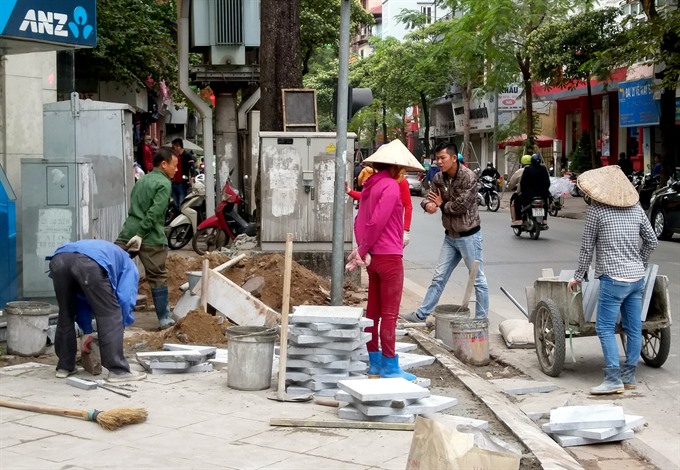 Society
Society

Shortcomings and violations in Hà Nội’s sidewalk paving have been pointed out after two months of investigation.
 |
| Workers pave sidewalk on Hàng Bún Street in Hà Nội. By the end of 2017, many inner districts have started resurfacing work on existing “degraded pavements” with slabs of natural stone that authorities claimed to be “sturdy for the next 50-70 years.” However, soon after, visible cracks and damage to the newly-laid pavements on many streets were reported to caused residents to question the quality of the material used.— VNS Photo Đoàn Tùng |
HÀ NỘI — Shortcomings and violations in Hà Nội’s sidewalk paving programme have been revealed following a two month investigation.
According to the conclusions of the city’s inspectorate, which were recently publicised, stones used for paving are mainly supplied by enterprises in central Thanh Hóa Province.
The investigation noted that the pavement design requirements remain unclear, leading to various sizes of stones used for cement concrete pavement. Also, stones were placed too close to each other, as each of them was 3cm thick, leading to weak connections between stones.
The responsibility for this was placed on the construction management division under the local Construction Department and design consulting unit- Hà Nội Consultant and Construction Investment Joint Stock Company.
The investigation also determined that Hoàng Mai, Cầu Giấy, and Thanh Xuân districts did not follow local authorities’ orders in inspecting sidewalks before paving, and failed to renovate urban landscapes, along with paving sidewalks.
According to the inspection results, the upgrading project of highway 6A’s pavement (Phùng Khoang-Ba Lan section) in Hà Đông District was not on the list of medium-term investment plans for the district in the 2013-2015 period.
In Long Biên and Hà Đông districts, paving projects were conducted on streets not in the centre or on streets where house construction has not been completed. After houses are built, pavement structures might be affected.
Paving was conducted in Ba Đình District (Nguyễn Trường Tộ, Nguyễn Khắc Nhu-Hàng Bún and Đội Cấn streets) and Hà Đông District, finding that electricity lines had not been buried underground and electricity poles and electrical substations had not been relocated.
The investigation also pointed out that no detailed studies of the pavement’s actual state was conducted. Further, the design of the pavement and technical infrastructure items was not completed in 19 projects in Ba Đình, Hai Bà Trưng, Hoàn Kiếm and Tây Hồ districts.
Further, inaccurate sidewalk structure designs or a lack off standards for stones, as instructed by local authorities, were found in 34 projects in eight districts. Also, the paving on Bà Triệu Street in Hà Đông District was discovered to have not included a waterproofing layer.
In addition, 28 projects in 11 districts were found to have false calculations of quantity and construction costs.
The investigation also clarified the responsibilities of units and individuals, including responsibilities of project design consultant units and design assessment units. The district’s urban management divisions and the urban management division of Hà Nội’s Construction Department must be held responsibility for assessing the projects, noted investigators.
By the end of 2016, many inner districts have started resurfacing work on existing “degraded pavements” with slabs of natural stone that authorities claimed to be “sturdy for the next 50-70 years.” The city planned to repave 936 streets in 12 districts by 2020.
The re-paving of sidewalks is one of the municipal People’s Committee’s measures to enhance the appearance of the city and improve “urban civility.”
However, visible cracks and damage to the newly-laid pavements on many streets were reported to caused residents to question the quality of the material used. — VNS




